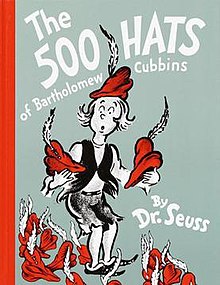The 500 Hats of Bartholomew Cubbins
 |
|
| Author | Dr. Seuss |
|---|---|
| Cover artist | Dr. Seuss |
| Country | United States |
| Language | English |
| Genre | Children's literature |
| Publisher | Vanguard Press |
|
Publication date
|
September 1, 1938 (renewed 1965) |
| Media type | Print (Hardcover) |
| OCLC | 192190 |
| Preceded by | And to Think That I Saw It on Mulberry Street |
| Followed by | The King's Stilts |
The 500 Hats of Bartholomew Cubbins is a children's book, written and illustrated by Theodor Geisel under the pen name Dr. Seuss and published by Vanguard Press in 1938. Unlike the majority of Geisel's books, it is written in prose rather than rhyming and metered verse. Geisel, who collected hats, got the idea for the story on a commuter train from New York to New England while he was sitting behind a businessman wearing a hat; the passenger was so stiff and formal that Geisel idly wondered what would happen if Geisel took his hat and threw it out the window. Geisel concluded that the man was so "stuffy" he would just grow a new one.
Set in feudal times, the story begins in the Kingdom of Didd, when King Derwin is riding through a street past peasant protagonist Bartholomew Cubbins. Ordered to remove his hat, according to the laws, Bartholomew does so, but another hat mysteriously appears; when he attempts to remove this one, yet another one appears; as this continues, the hats begin to grow in extravagance and beauty from the 451st hat onwards. Ultimately the 500th hat, studded with massive gems and gilding, leaves Bartholomew's head bare. Stunned by the beauty of the hat, King Derwin grants him reprieve and trades him 500 gold coins for the 500th hat.
The book received positive reviews from critics. The New York Times reviewer called the book "a lovely bit of tomfoolery which keeps up the suspense and surprise until the end."Booklist, which had criticized Geisel's previous book, And to Think That I Saw It on Mulberry Street, for containing only enough material for one comic strip, praised The 500 Hats as "a brand-new idea, developed into a complete tale, not too long, not too short, just right. Somewhere between the Sunday supplements and the Brothers Grimm, Dr. Seuss has produced a picture book combining features of both." Alexander Laing, who had worked with Geisel on the Dartmouth Jack-O-Lantern humor magazine, wrote in his review of the book in the Dartmouth Alumni Magazine, "His several other occupations, madly fascinating as they are, may have been only preludes to a discovery of his proper vocation. That he is a rare and loopy genius has been common knowledge from an early epoch of his undergrad troubles. It now becomes plain that his is the self-consistent, happy madness beloved by children. I do not see what is to prevent him from becoming the Grimm of our times."
...
Wikipedia
